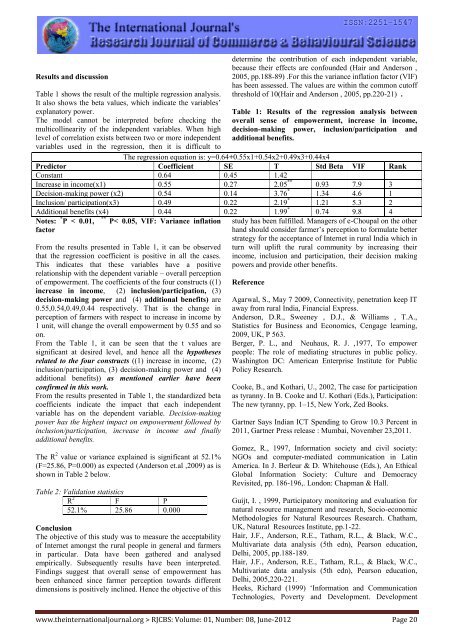Research Journal of Commerce & Behavioural Science - RJCBS
Research Journal of Commerce & Behavioural Science - RJCBS
Research Journal of Commerce & Behavioural Science - RJCBS
You also want an ePaper? Increase the reach of your titles
YUMPU automatically turns print PDFs into web optimized ePapers that Google loves.
Results and discussion<br />
Table 1 shows the result <strong>of</strong> the multiple regression analysis.<br />
It also shows the beta values, which indicate the variables’<br />
explanatory power.<br />
The model cannot be interpreted before checking the<br />
multicollinearity <strong>of</strong> the independent variables. When high<br />
level <strong>of</strong> correlation exists between two or more independent<br />
variables used in the regression, then it is difficult to<br />
From the results presented in Table 1, it can be observed<br />
that the regression coefficient is positive in all the cases.<br />
This indicates that these variables have a positive<br />
relationship with the dependent variable – overall perception<br />
<strong>of</strong> empowerment. The coefficients <strong>of</strong> the four constructs ((1)<br />
increase in income, (2) inclusion/participation, (3)<br />
decision-making power and (4) additional benefits) are<br />
0.55,0.54,0.49,0.44 respectively. That is the change in<br />
perception <strong>of</strong> farmers with respect to increase in income by<br />
1 unit, will change the overall empowerment by 0.55 and so<br />
on.<br />
From the Table 1, it can be seen that the t values are<br />
significant at desired level, and hence all the hypotheses<br />
related to the four constructs ((1) increase in income, (2)<br />
inclusion/participation, (3) decision-making power and (4)<br />
additional benefits)) as mentioned earlier have been<br />
confirmed in this work.<br />
From the results presented in Table 1, the standardized beta<br />
coefficients indicate the impact that each independent<br />
variable has on the dependent variable. Decision-making<br />
power has the highest impact on empowerment followed by<br />
inclusion/participation, increase in income and finally<br />
additional benefits.<br />
The R 2 value or variance explained is significant at 52.1%<br />
(F=25.86, P=0.000) as expected (Anderson et.al ,2009) as is<br />
shown in Table 2 below.<br />
Table 2: Validation statistics<br />
R 2 F P<br />
52.1% 25.86 0.000<br />
Conclusion<br />
The objective <strong>of</strong> this study was to measure the acceptability<br />
<strong>of</strong> Internet amongst the rural people in general and farmers<br />
in particular. Data have been gathered and analysed<br />
empirically. Subsequently results have been interpreted.<br />
Findings suggest that overall sense <strong>of</strong> empowerment has<br />
been enhanced since farmer perception towards different<br />
dimensions is positively inclined. Hence the objective <strong>of</strong> this<br />
determine the contribution <strong>of</strong> each independent variable,<br />
because their effects are confounded (Hair and Anderson ,<br />
2005, pp.188-89) .For this the variance inflation factor (VIF)<br />
has been assessed. The values are within the common cut<strong>of</strong>f<br />
threshold <strong>of</strong> 10(Hair and Anderson , 2005, pp.220-21) .<br />
Table 1: Results <strong>of</strong> the regression analysis between<br />
overall sense <strong>of</strong> empowerment, increase in income,<br />
decision-making power, inclusion/participation and<br />
additional benefits.<br />
The regression equation is: y=0.64+0.55x1+0.54x2+0.49x3+0.44x4<br />
Predictor Coefficient SE T Std Beta VIF Rank<br />
Constant 0.64 0.45 1.42<br />
Increase in income(x1) 0.55 0.27 2.05 ** 0.93 7.9 3<br />
Decision-making power (x2) 0.54 0.14 3.76 * 1.34 4.6 1<br />
Inclusion/ participation(x3) 0.49 0.22 2.19 * 1.21 5.3 2<br />
Additional benefits (x4) 0.44 0.22 1.99 * 0.74 9.8 4<br />
Notes: * P < 0.01,<br />
**<br />
P< 0.05, VIF: Variance inflation study has been fulfilled. Managers <strong>of</strong> e-Choupal on the other<br />
factor<br />
hand should consider farmer’s perception to formulate better<br />
strategy for the acceptance <strong>of</strong> Internet in rural India which in<br />
turn will uplift the rural community by increasing their<br />
income, inclusion and participation, their decision making<br />
powers and provide other benefits.<br />
Reference<br />
Agarwal, S., May 7 2009, Connectivity, penetration keep IT<br />
away from rural India, Financial Express.<br />
Anderson, D.R., Sweeney , D.J., & Williams , T.A.,<br />
Statistics for Business and Economics, Cengage learning,<br />
2009, UK, P 563.<br />
Berger, P. L., and Neuhaus, R. J. ,1977, To empower<br />
people: The role <strong>of</strong> mediating structures in public policy.<br />
Washington DC: American Enterprise Institute for Public<br />
Policy <strong>Research</strong>.<br />
Cooke, B., and Kothari, U., 2002, The case for participation<br />
as tyranny. In B. Cooke and U. Kothari (Eds.), Participation:<br />
The new tyranny, pp. 1–15, New York, Zed Books.<br />
Gartner Says Indian ICT Spending to Grow 10.3 Percent in<br />
2011, Gartner Press release : Mumbai, November 23,2011.<br />
Gomez, R., 1997, Information society and civil society:<br />
NGOs and computer-mediated communication in Latin<br />
America. In J. Berleur & D. Whitehouse (Eds.), An Ethical<br />
Global Information Society: Culture and Democracy<br />
Revisited, pp. 186-196,. London: Chapman & Hall.<br />
Guijt, I. , 1999, Participatory monitoring and evaluation for<br />
natural resource management and research, Socio-economic<br />
Methodologies for Natural Resources <strong>Research</strong>. Chatham,<br />
UK, Natural Resources Institute, pp.1-22.<br />
Hair, J.F., Anderson, R.E., Tatham, R.L., & Black, W.C.,<br />
Multivariate data analysis (5th edn), Pearson education,<br />
Delhi, 2005, pp.188-189.<br />
Hair, J.F., Anderson, R.E., Tatham, R.L., & Black, W.C.,<br />
Multivariate data analysis (5th edn), Pearson education,<br />
Delhi, 2005,220-221.<br />
Heeks, Richard (1999) ‘Information and Communication<br />
Technologies, Poverty and Development. Development<br />
www.theinternationaljournal.org > <strong>RJCBS</strong>: Volume: 01, Number: 08, June-2012 Page 20
















